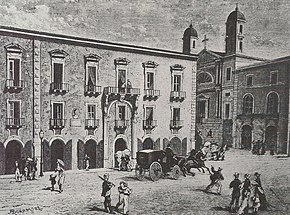
Piazza del Duomo is the main piazza of Milan, Italy. It is named after, and dominated by, Milan Cathedral. The piazza marks the center of the city, both in a geographic sense and because of its importance from an artistic, cultural, and social point of view. Rectangular in shape, with an overall area of 17,000 m2, the piazza includes some of the most important buildings of Milan, as well some of the most prestigious commercial activities, and it is by far the foremost tourist attraction of the city.

Palazzo Braschi is a large Neoclassical palace in Rome, Italy and is located between the Piazza Navona, the Campo de' Fiori, the Corso Vittorio Emanuele II and the Piazza di Pasquino. It presently houses the Museo di Roma, the "Museum of Rome", covering the history of the city in the period from the Middle Ages through the nineteenth century.
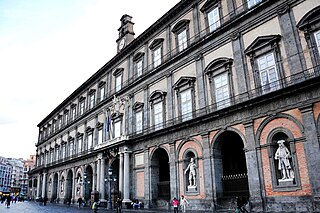
The Royal Palace of Naples is a palace, museum, and historical tourist destination located in central Naples, southern Italy.

Piazza della Repubblica is a city square in Florence, Italy. It was originally the site of the city's forum; then of its old ghetto, which was swept away during the improvement works, or Risanamento, initiated during the brief period when Florence was the capital of a reunited Italy—work that also created the city's avenues and boulevards. At that time, the Loggia del Pesce from the Mercato Vecchio was also moved to Piazza Ciompi. The square's Giubbe Rosse cafe has long been a meeting place for famous artists and writers, notably those of Futurism.

The Palazzo Biscari is a monumental private palace located on Via Museo Biscari in Catania, Sicily, southern Italy. The highly decorative interiors are open for guided tours, and used for social and cultural events.

The Palazzo Tezzano is a monumental palace in Piazza Stesicoro, in the center of Catania, Sicily, southern Italy. The via Etnea, with prominent shops, bisects the Piazza; this palazzo rises at the northwest intersection with this via, across from the white stone, neoclassical Palazzo Paterno del Toscano.

Piazza della Scala is a pedestrian central square of Milan, Italy, connected to the main square of Milan, Piazza del Duomo, by the Galleria Vittorio Emanuele II passage. It is named after the renowned Teatro alla Scala opera house, which occupies the north-western side of the square; the building actually includes both the opera house and the Museo Teatrale alla Scala, dedicated to the history of La Scala and opera in general. On the opposite side to "La Scala", to the south-east, is the facade of Palazzo Marino, Milan's city hall. Another relevant building on the square, on the north-eastern side, is the Palazzo della Banca Commerciale Italiana. The south-western side of the square has the entry to the Galleria Vittorio Emanuele as well as Palazzo Beltrami. Most of the architecture of the square is due to architect Luca Beltrami, who designed the eponymous palace, the facade of Palazzo Marino, and the Banca Commerciale Italiana building. The centre of the square is marked by the monument of Leonardo da Vinci by sculptor Pietro Magni (1872).
Piazza del Duomo is the main city square in Catania, Italy, flanked by both the centers of civic and religious power.

San Placido is a Roman Catholic church and former-Benedictine monastery located on the piazza of the same name in Catania, Sicily, southern Italy. The complex, two blocks east of the Catania Cathedral, spans a polygonal block encompassed by the Via Vittorio Emanuele II on the north, the via Landolina to the east, the via Museo Biscari on a south diagonal, and to the west the piazza San Placido and Via Porticello. Part of the convent is occupied by the Palazzo della Cultura, used for cultural activities and exhibitions. The Monastero di San Placido also serves presently as the Archivio di Stato di Catania.

San Francesco d'Assisi all'Immacolata is a Roman Catholic church in the city of Catania, Sicily, southern Italy.

The Palazzo San Giuliano is a monumental palace located in Piazza Universitaria, in the center of the city of Catania, Sicily, southern Italy. Once a private home of the San Giuliano branch of the House of Paternò, it has also served as hospital, bank, theater, and hotel. Presently it houses the administrative offices of the University of Catania, and stands across the piazza from the Palazzo dell'Università, which has the rector's offices, a library, and a small museum.

The Roman Theatre of Catania consists of the ruins of two open-air semicircular ancient Roman theatres, located between Piazza San Francesco, via Vittorio Emanuele, via Timeo, and via Teatro Greco in the center of Catania, Sicily, southern Italy. The site consists of a larger theatre and a smaller semicircular theatre, an Odeon. The structure is part of the Parco archeologico greco-romano di Catania.

The Palazzo dell'Università or Palazzo Centrale dell'Università di Catania is a monumental palace located in Piazza Universitaria, in the center of the city of Catania, region of Sicily, southern Italy. Since its construction, it has housed the main offices of the University of Catania, and stands across the piazza from the Palazzo San Giuliano, also housing offices of the university. It presently houses the offices of the rector, university offices, the "Giambattista Caruso" Regional Library, and a small museum of geology and archeology.
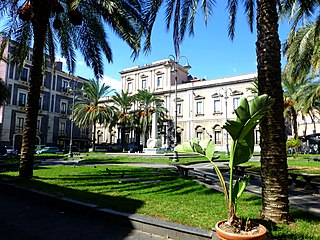
The Palazzo Cutelli is a historic palace, once housing the Collegio Cutelli, now the semiprivate Convitto Cutelli, a boarding school from primary to lyceum grades, located on Via Vittorio Emanuele #56 in central Catania, region of Sicily, Italy.
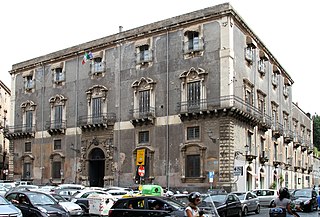
The Palazzo Manganelli is a Baroque monumental palace located in Piazza Manganelli, in the center of the city of Catania, region of Sicily, southern Italy. It is still lived in by heirs of the family, and also houses a hotel. The busy piazza serves mainly as a parking lot; at the north is a civic art gallery, housed in the former church of San Michele Minore. To the south, across Via Antonino di Sangiuliano stands the Teatro Sangiorgi. At one time, a building here housed the Istituto per la Educazione delle Fanciulle.

The Palazzo Paternò del Toscano, also known as the Palazzo del Toscano, is an notable palace in Piazza Stesicoro, in the center of Catania, region of Sicily, southern Italy. The building now houses many shops, but is also used by schools, and for cultural programs. The white stone facade stands before the Monument to Vincenzo Bellini and rises in contrast to the palace across via Aetna, the white and black Palazzo Tezzano.

The Palazzo Gioeni Asmundo is an notable palace located on via Fragalà #10 facing Piazza dell'Università in the center of Catania, region of Sicily, southern Italy. The building, like the two other prominent palaces facing this piazza, now houses offices of the University of Catania.

The Palazzo del Seminario dei Chierici, also known as the Palazzo dei Chierici is a monumental building located facing the piazza Duomo in Catania, region of Sicily, Italy. It stands aside from the Cathedral of Sant'Agata, and across the piazza from the Palazzo degli Elefanti, which houses city hall. Between these two palaces, the Monument of the Elephant with obelisk is located.
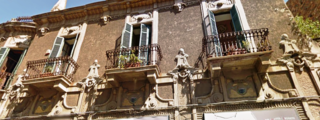
The Garage Musumeci is an notable building, elaborated in a flamboyant Liberty style, and built to house both an automobile showroom on the ground floor and above the apartments of the owner, Baron Musemeci. It is located in Piazza Bovio, at the intersection of Via Conte di Torino and Via Francesco Crispi, in the city of Catania, region of Sicily, Italy.
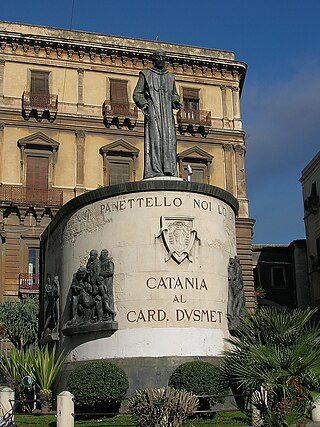
The Monument to the Blessed Giuseppe Dusmet or Statua Cardinale Beato Dusmet is an outdoor monument and statue located on Piazza San Francesco d'Assisi, located between the church of San Francesco and the Palazzo Gravina-Cruyllas in the city of Catania, Sicily, Italy.

